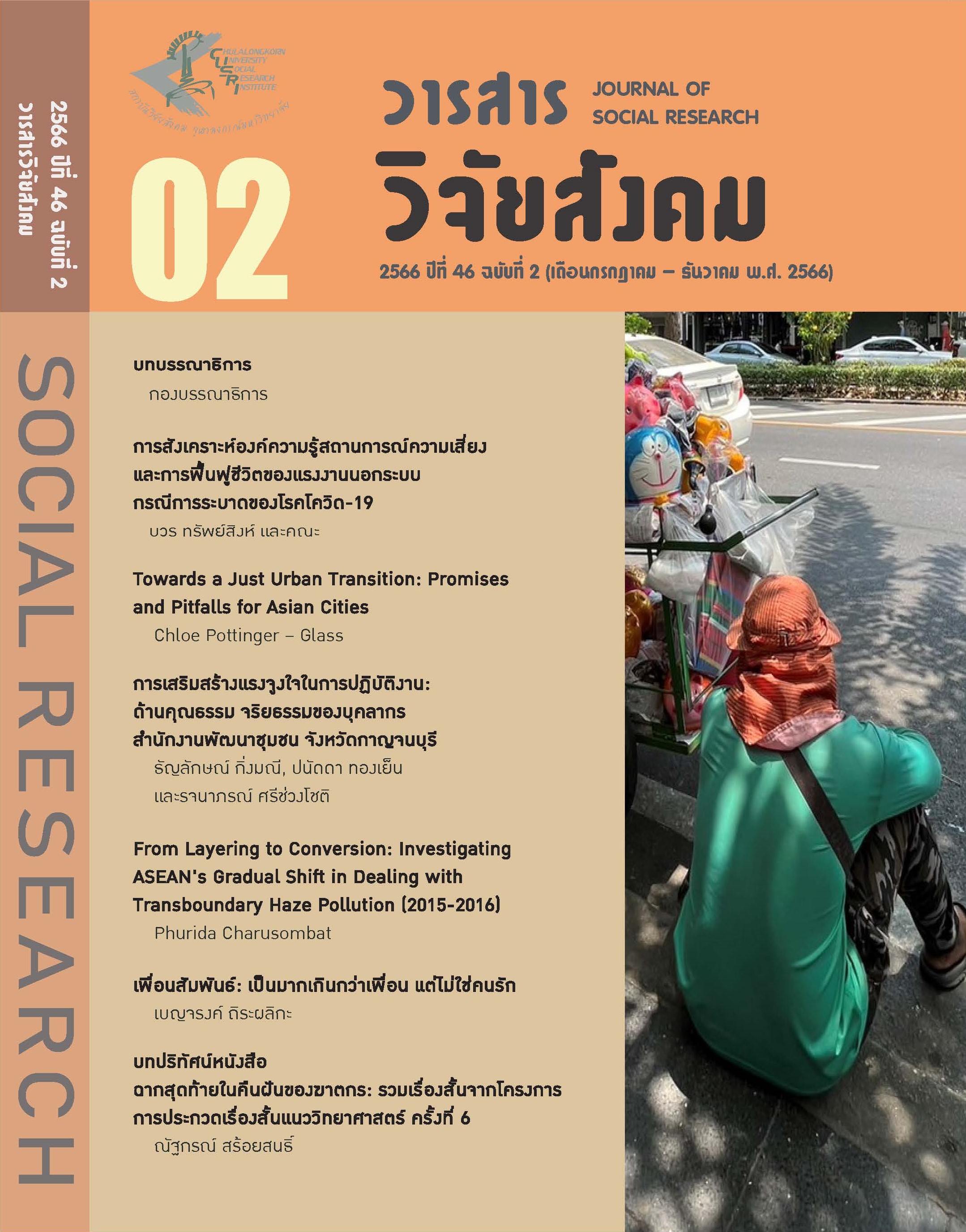From Layering to Conversion Investigating ASEAN's Gradual Shift in Dealing with Transboundary Haze Pollution (2015-2016)
Main Article Content
บทคัดย่อ
นับตั้งแต่มีการดำเนินการตามความตกลงอาเซียนว่าด้วยมลพิษ
จากหมอกควันข้ามพรมแดน (AATHP) ในปี พ.ศ. 2546 อาเซียนได้มี
การเปลี่ยนแปลงเชิงสถาบันอย่างค่อยเป็นค่อยไปตั้งแต่ปี พ.ศ. 2546 - 2563 จากกระบวนการเปลี่ยนแปลงแบบ layering เป็น แบบ conversion ซึ่งการเปลี่ยนแปลงทางสถาบันดังกล่าวเกี่ยวข้องกับการเพิ่มองค์ประกอสนับสนุนและผู้มีบทบาทในการดำเนินการตามข้อตกลงระดับภูมิภาค รวมทั้งการนำโรดแมปอาเซียนปลอดหมอกควันข้ามแดน (พ.ศ. 2559 - 2563) มาใช้โดยมีการตีความบางมาตราของความตกลง AATHP ใหม่ให้อยู่ภายใต้การดำเนินงานตามกรอบยุทธศาสตร์ของโรดแมปอาเซียนปลอดหมอกควันข้ามแดนเพื่อจัดการกับปัญหาสิ่งแวดล้อมดังกล่าวอย่างครอบคลุม อย่างไรก็ตามการเปลี่ยนแปลงสถาบันอาเซียนจากแบบ layering เป็น conversion ในระหว่างปี พ.ศ. 2558 - 2559 ยังคงเป็นประเด็นที่ยังไม่ได้สำรวจการศึกษานี้ใช้กรอบทฤษฎีเชิงพลวัตของ Koreh et al. (2019) เกี่ยวกับการเปลี่ยนแปลงเชิงสถาบันอย่างค่อยเป็นค่อยไป เพื่อให้ความกระจ่างเกี่ยวกับสถานการณ์และผู้มีบทบาทหลักที่อยู่เบื้องหลังการเปลี่ยนแปลงสถาบันของอาเซียนในช่วงปี พ.ศ. 2558 - 2559 ข้อค้นพบของการศึกษานี้ได้เน้นย้ำถึงบทบาทที่สำคัญของคณะกรรมการอาเซียน โดยเฉพาะคณะกรรมการขับเคลื่อน ระดับอนุภูมิภาคว่าด้วยมลพิษจากหมอกควันข้ามแดนในอนุภูมิภาคลุ่มแม่น้ำโขง (MSC-Mekong) ซึ่งนำโดยประเทศไทย และรัฐมนตรีสิ่งแวดล้อม อาเซียนภายใต้การประชุมประเทศภาคีต่อความตกลงระดับภูมิภาคดังกล่าว (COP) การศึกษานี้ยังพบว่ามีเหตุการณ์สำคัญสองเหตุการณ์ในปี พ.ศ. 2558 โดยเฉพาะอย่างยิ่งวิกฤตหมอกควันในภูมิภาคเอเชียตะวันออกเฉียงใต้ได้ทำหน้าที่ เป็นตัวเร่งปฏิกิริยากระตุ้นให้เกิดการเปลี่ยนแปลงเชิงสถาบันของอาเซียน ในการพัฒนาการแก้ไขปัญหาสิ่งแวดล้อมระหว่างภูมิภาคดังกล่าว ซึ่งนำไปสู่ การดำเนินการโรดแมปอาเซียนปลอดหมอกควันข้ามแดนในปี พ.ศ. 2559 กระบวนการเปลี่ยนแปลงนี้ได้เพิ่มความมุ่งมั่นในการบรรลุเป้าหมายของอาเซียน ในการกำจัดหมอกควันให้หมดสิ้นภายในปี พ.ศ. 2563 รวมทั้งเป็นการส่งเสริม ความร่วมมือที่เพิ่มขึ้นในการจัดการกับมลพิษหมอกควันข้ามพรมแดนทั่วทั้งภูมิภาคด้วย
Article Details

This work is licensed under a Creative Commons Attribution-NonCommercial-NoDerivatives 4.0 International License.
1) บทความนี้เป็นลิขสิทธิ์ของสถาบันวิจัยสังคม จุฬาลงกรณ์มหาวิทยาลัย แต่ความคิดเห็นและเนื้อหาเป็นของผู้แต่ง
2) ทัศนะและความคิดเห็นที่ปรากฏในบทความในวารสารวิจัยสังคมและปริทัศน์ สถาบันวิจัยสังคม จุฬาลงกรณ์มหาวิทยาลัย ถือเป็นความรับผิดชอบของผู้แต่งบทความนั้น และไม่ถือเป็นทัศนะและความรับผิดชอบของกองบรรณาธิการวารสารวิจัยสังคมและปริทัศน์ สถาบันวิจัยสังคม จุฬาลงกรณ์มหาวิทยาลัย กองบรรณาธิการไม่สงวนสิทธิ์ในการคัดลอก แต่ให้ระบุถึงการอ้างอิง
References
Alam, S., & Nurhidayah, L. (2017). The international law on transboundary haze pollution: What can we learn from the southeast asia region? Review of European, Comparative & International Environmental Law, 26(3), 243-254.
ASEAN Secretariat. (2015). Media Release of 5th Meeting of the Sub-Regional Ministerial Steering Committee on Transboundary Haze Pollution in the Mekong Sub-Region. (Online). Available: https://hazeportal.asean.org/media_release/media-release-of-5th-meeting-of-the-sub-regional-ministerial-steering-committee-on-transboundary-haze-pollution-in-the-mekong-sub-region/ (Accessed 20 October 2023).
ASEAN Secretariat. (2016). ASEAN agreement on transboundary haze pollution. (Online). Available: https://hazeportal.asean.org/publications/asean-agreement-on-transboundary-haze-pollution/ (Accessed 20 October 2023).
ASEAN Secretariat. (2021). Roadmap on ASEAN cooperation towards transboundary haze pollution control with means of implementation. (Online). Available: https://asean.org/wp-content/uploads/2021/01/Roadmap-ASEAN-Haze-Free_adoptedbyCOP12.pdf (Accessed 20 October 2023).
Caballero-Anthony, M. (2018). Negotiating governance on non-traditional security in southeast asia and beyond. Columbia University Press.
Capano, G. (2019). Reconceptualizing layering—From mode of institutional change to mode of institutional design: Types and outputs. Public Administration, 97(3), 590-604.
Charusombat, P. (2023). ASEAN cooperation on transboundary haze pollution: The perspective of institutional incremental change. Journal of Environmental Information Science, 2022(2), 1-12.
Fongissara, N., & Buddharaksa, W. (2022). ASEAN agreement on transboundary haze pollution management in mainland southeast asia. Asia Social Issues, 15(6), 253039.
Hacker, J. S., Pierson, P., & Thelen, K. (2015). Drift and conversion: Hidden faces of institutional change. Advances in Comparative-Historical Analysis, 180-208.
Heilmann, D. (2015). After indonesia's ratification: The ASEAN agreement on transboundary haze pollution and its effectiveness as a regional environmental governance tool. Journal of Current Southeast Asian Affairs, 34(3), 95-121.
Koreh, M., Mandelkern, R., & Shpaizman, I. (2019). A dynamic theoretical framework of gradual institutional changes. Public Administration, 97(3), 605-620.
Mahoney, J., & Thelen, K. (2010). A theory of gradual institutional change. Explaining Institutional Change: Ambiguity, Agency, and Power, 1, 1.
Nazeer, N., & Furuoka, F. (2017). Overview of asean environment, transboundary haze pollution agreement and public health. International Journal of Asia-Pacific Studies, 13(1)
Nguitragool, P. (2011). Negotiating the haze treaty: Rationality and institutions in the negotiations for the ASEAN agreement on transboundary haze pollution (2002). Asian Survey, 51(2), 356-378.
Nurhidayatuloh, F., Apriandi, M., Annalisa, Y., Sulistyaningrum, H. P., Handayani, I., Zuhro, F., Jaelani, A. K., & Tedjomurti, K. (2020). Transboundary haze-free for southeast asian countries by 2020: A delusional vision? International Journal of Psychosocial Rehabilitation, 24(2), 1923-1929.
Quah, E., & Tan, T. S. (2018). Pollution across borders: Transboundary fire, smoke and haze in southeast asia. World Scientific.
Streeck, W., & Thelen, K. (2005). Beyond continuity: Institutional change in advanced political economies. Oxford University Press.
Sunchindah, A. (2015). Transboundary haze pollution problem in Southeast Asia: Reframing ASEAN’s response (No. DP-2015-82).
Van der Heijden, J. (2010). A short history of studying incremental institutional change: Does explaining institutional change provide any new explanations? Regulation & Governance, 4(2), 230-243.
Van der Heijden, J. (2011). Institutional layering: A review of the use of the concept. Politics, 31(1), 9-18.
Varkkey, H. (2012). The asean way and haze mitigation efforts. Journal of International Studies, 8, 77-97.
Varkkey, H. (2017). 40 years of ASEAN environmental governance: Enhancing asean centrality through the ASEAN plus three (APT). MJIR| Malaysian Journal of International Relations, 5(1), 47-65.
Varkkey, H. (2022). Emergent geographies of chronic air pollution governance in southeast asia: Transboundary publics in singapore. Environmental Policy and Governance, 32(4), 348-361.

